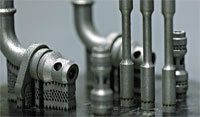The rise of additive manufacturing
Dream machines: Systems capable of printing functional components are poised to enter the manufacturing mainstream
Prof Richard Hague’s desk is littered with a curious smorgasbord of objects: a tiny model jet engine, a diesel-fuel pump housing, a chain-mail vest with a zip down the back, a football shin pad and a tiny skeletal hand. A seemingly random array of objects, but with one important thing in common: they’ve all been built by machines that can be used to print functional components from scratch.
Hague, who heads up Loughborough University’s world-leading Additive Manufacturing Research Group (AMRG), explained that these so-called ’additive’ machines, which use a range of laser-based or advanced printing techniques to build up models layer by layer, have a number of compelling advantages over traditional manufacturing techniques.

Able to build models of mind-boggling geometrical complexity from scratch, they dispense with tooling costs. Plus, there’s very little waste. While traditional ’subtractive’ manufacturing processes often remove up to 95 per cent of the raw material to arrive at a finished component, additive machines only use the material they need to make the part.
Register now to continue reading
Thanks for visiting The Engineer. You’ve now reached your monthly limit of premium content. Register for free to unlock unlimited access to all of our premium content, as well as the latest technology news, industry opinion and special reports.
Benefits of registering
-
In-depth insights and coverage of key emerging trends
-
Unrestricted access to special reports throughout the year
-
Daily technology news delivered straight to your inbox










Water Sector Talent Exodus Could Cripple The Sector
Maybe if things are essential for the running of a country and we want to pay a fair price we should be running these utilities on a not for profit...